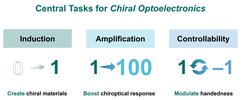Research

The Chiral Optoelectronics Group focuses on three main aspects of chiral materials and their semiconductor devices: chirality induction, chiroptical response amplification, and chiral signal control. Chirality induction is a crucial method for creating chiral materials, distinct from molecular-level synthesis. It emphasizes the creation of chiral materials in solid states and the cost-effective conversion from non-chiral to chiral conformations within semiconductor materials. These structural conversions also lead to changes in the electronic structures of the materials, resulting in the formation of excited states that correspond to circularly polarized light emission and absorption. Engineering these excited states and enhancing chiroptical responses will be the second task of our group. The final task involves achieving ultimate control over chiral light signals in optoelectronic devices. Unlike non-chiral optoelectronics, we generate light with additional chiral information beyond conventional optical properties such as intensity and spectral characteristics. Therefore, understanding how to fully control and modulate polarization through electrical operations is essential.
Research Interests

Chiral (inter-)molecular interactions: Building chiral organic semiconductor thin films relies on the precise control of molecular interactions within the compositions, such as emitter-host materials in light-emitting devices or donor-acceptor interactions in photodetectors[1]. The group will investigate the morphological and molecular dynamic origins of chirality induction in semiconducting molecules.
Chiral light-matter interactions: The key to achieving strongly circularly polarized light emission or selective absorption lies in constructing chiral excited states. Whether during charge recombination or charge separation, excitons are at the core of light-matter interaction. Full control over chiral excited state formation enables precise tuning of the exciton population corresponding to left- or right-handed circularly polarized responses. The group will explore exciton engineering methods to amplify chiroptical responses in organic semiconductor materials.
Charge-photon interactions: Beyond charge recombination, chiral organic semiconductors also serve as transport sites, allowing charge carrier injection from electrodes or extraction to electrodes. When charge carriers flow through chiral materials, angular momentum, or chiral information, is accumulated[2]. This accumulation depends on the charge carrier flow direction and photon emission direction, thereby regulating the resulting circularly polarized emission in electronic devices. The group will harness these topological characteristics of chiral materials to build chiroptoelectronics for the precise and rapid generation of circularly polarized light signals.

